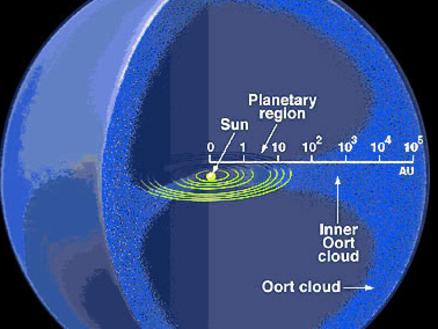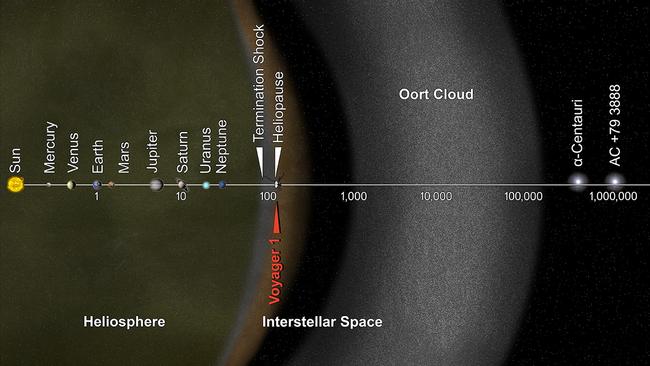There’s a fleet of ‘Death Stars’ headed our way. This time destruction really could be rained down upon us all: But there’s still time to linger over a Star Wars sequel or three (hundred thousand).
WAYWARD orange dwarf star HIP-85605 is on an intercept course with our solar system. Odds are as high as 90 per cent it will crash into our Oort cloud — an enormous ‘bubble’ of comets that surrounds our Sun — sometime between 240,000 and 470,000 years from now.
And it’s not the only one: There are possibly more than a dozen such ‘Death Stars’ racing our way.
A paper to be published in the journal Astronomy & Astrophysics by astrophysicist Coryn Bailer-Jones of Germany’s Max Planck Institute for Astronomy reveals that there are 14 wandering stars that will pass within three light years of Earth.
HIP-85605 appears likely to become our closest encounter.
It is a cool K-class dwarf star currently 16 light years away, approaching from the direction of the Hercules constellation. It will likely skim past our Solar System at a mere 0.13 to 0.65 light years (roughly 8000 times the distance between the Earth and the Sun).
THE SEARCH FOR EARTH 2.0: Exploring exoplanets
Another seems close behind. The star designated Gliese 710 has been calculated as having a 90 per cent chance of coming within our sphere of influence. Currently lurking some 64 light years away in the Serpens constellation, it’s expected to land in our neighbourhood sometime between 1.3 and 1.5 million years from now.
To put this in perspective: Our closest neighbouring star is Proxima Centauri, a red dwarf some 4 light years away
When Bailer-Jones extended his study to include all 50,000 stars upon which we have accurate ‘fixes’ for — including their distances, directions and velocities — it revealed 14 stars on courses that would bring them into range of our Solar System in the next two million years.
We’ve already experienced a ‘near-miss’: The white dwarf Van Maanen’s star — fortuitously ‘burnt-out’ — came close to our Sun some 15,000 years ago. Exactly what impact its passing had is as yet unknown.
It may sound like an interstellar game of billiards. In many ways it is. But even when they arrive, Swinburn University astrophysicist Dr Alan Duffy say’s not to expect being swallowed by a star.
THE OTHER DEATH STAR: Will Eta Carinae destroy Earth?
The scale of things is simply too great.
Instead, the threat will be what happens to the masses of comets orbiting in our Solar System’s outskirts — out to as far as one light-year.
“Objects hardly ever meet in space — the distances are so huge — but the gravitational influence of a star is enormous, even something a light-year away can rattle the loosely held Oort Cloud objects,” Dr Duffy says. “(But) there’s no doubt that nearby stars in the past have nudged Oort objects into falling towards the inner solar system.“

In the face of a fully armed an operational Death Star such as HIP-85605 or Gliese 710, Admiral Akbar would rightly say we “can’t repel firepower of that magnitude”.
Stars are impressive. They’re big. They’re fractious. They’re thermonuclear.
Even our own — a somewhat humble, small specimen — can cast worrisome clouds of superheated plasma our way.
So the real questions are: Are we really in the firing line, what is being fired at us — and what are the chances of a bullseye?
Interstellar push-and-pull:
We’re fairly safe down here. It’s taken millions of years, but Jupiter has managed to clean up most of the inner Solar System by pulling wayward comets and asteroids into its heavy embrace. But it is a fragile balance. Those distant, tumbling mountains of rock and ice can be sent wobbling towards us.
The fear is Earth — and all the inner planets — could be subjected to a bombardment not seen for millions of years: ‘Death Star’ Gamma Microscopii (HIP103738) appears to have already drifted to within a light-year of our Sun by 3,850,000 years ago. There are two impact craters on Earth that could possibly be attributed to this event.
Bake’n’shake:
If the ‘Death Star’ was a hot one, could its powerful UV radiation be added to the planet-killing arsenal it unleashes? Such radiation could tear apart the DNA of living all things once our thin line of defence — the ozone layer — is stripped away.
As Dr Duffy says, it’d have to get extremely close — impossibly close — for its radiation and gravity to have any direct effect.
Gamma Microscopii, the G-7 giant which whizzed past some four million years ago, is believed to have been about 2.5 times the size of our own Sun. Its radiation is not known to have had any effect on our world.
“None of the stars that will likely come close to us are particularly large or bright meaning that they won’t affect the Earth with their UV or heating directly,” he says. “A star 100 times more luminous than our Sun would have to get as close to the Earth as Jupiter for it to be brighter than the Sun in our sky. If it’s a smaller star then it would have to get even closer. Long before then the gravity of this intruder would already have likely flung the Earth out of our orbit. Thankfully no star is predicted to come that close!”

Supernovas:
Each ‘Death Star’ will take about 30,000 years to pass through our Oort Cloud. We will remain in their ‘spheres’ of influence’ for tens of thousands of years more. There is a remote chance one of them may reach the end of its life cycle and explode during that time.
“We see radioactive isotopes on Earth which point to nearby supernovas over the past few million years,” said Dr Bailer-Jones.
But Dr Duffy says the odds of one of these stars exploding when close enough to have any impact (and that means within several light years) is infinitesimal.
“However the main reason this isn’t a worry is that none of the nearby stars that are drifting towards us from this study are big enough to explode as a supernova,” he says.
No. But these stars have a typically Imperial problem: Accuracy.
And, by the time the first of these Death Stars arrive, our race will either already be dead — or so highly evolved as to simply not care.
“While a direct collision by a large comet would be a disaster for the Earth we’re actually a very small target,” Dr Duffy says. “A much bigger target is the gas giant Jupiter with an enormous gravitational pull that attracts the comets and ‘cleans’ up the Solar System. Yet even Jupiter is tiny on that scale so it’s much more likely that any comets that tumble in towards us will just pass harmlessly by.”
Even if these stars did tumble any Oort objects out of orbit, these could take up to two million years to drift into the inner planets.
Many of the stars set to cross our path are dwarf stars smaller than our own. This means the potential influence they may have on our Oort cloud will be limited.
We can get more Bothan-like data (without the casualties) right now: Instead of R2D2, the carrier of such secret plans would be the European Space Agency’s Gaia telescope. It is can help pinpoint the tracks of these deadly interstellar bodies to determine how many are on the way — and which ones may have done us damage in the past.
It’s currently cataloguing over a billion objects in our interstellar neighbourhood.
“The Gaia satellite is currently in space creating the best map yet of all the nearby stars allowing us to know to great accuracy just which of the billions of stars in our galaxy will likely ever get close enough to cause us problems,” Dr Duffy says.
The results are due to be in by 2016.
It’s just such data Dr Bailer-Jones is waiting for. He is now working on a study to figure out the probability of Earth being hit by one of these deflected comets.
“Even though the galaxy contains very many stars,” Bailer-Jones told Universe Today, “the spaces between them are huge. So even over the (long) life of our galaxy so far, the probability of any two stars have actually collided — as opposed to just coming close — is extremely small.”
As always, the devil is in the detail.


Here’s what you can expect with tomorrow’s Parramatta weather
As spring moves into summer what can locals expect tomorrow? We have the latest word from the Weather Bureau.
Here’s what you can expect with tomorrow’s Parramatta weather
As spring moves into summer what can locals expect tomorrow? We have the latest word from the Weather Bureau.